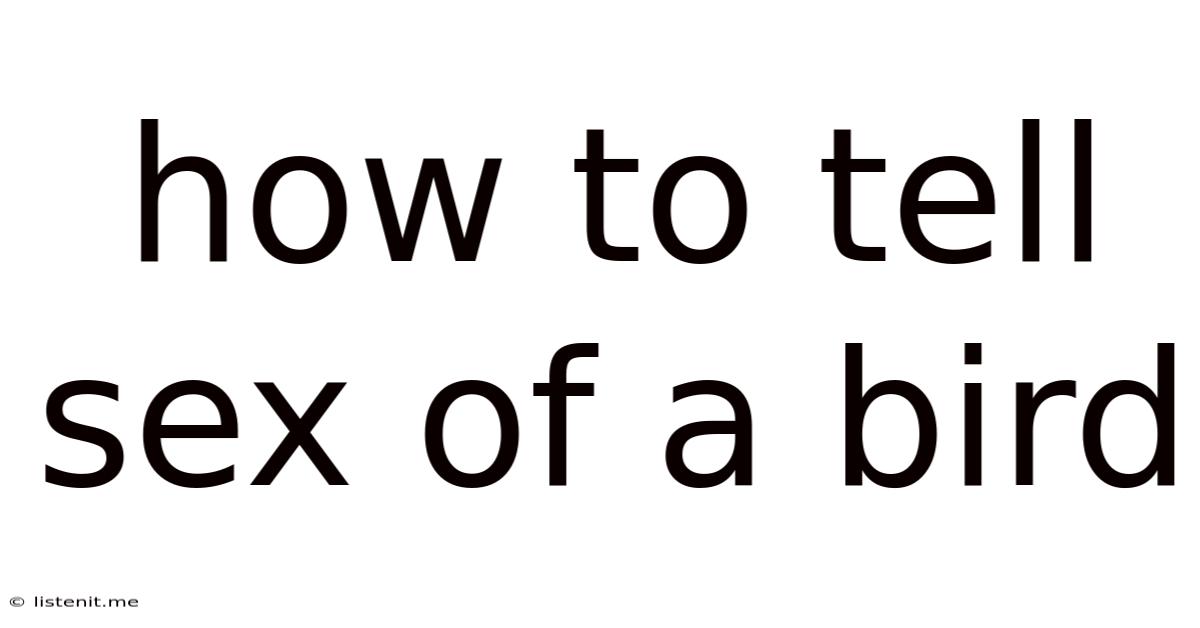How To Tell Sex Of A Bird
listenit
Jun 13, 2025 · 4 min read

Table of Contents
How to Tell the Sex of a Bird: A Comprehensive Guide
Determining the sex of a bird can be a challenging task, even for experienced bird watchers. Unlike mammals with easily discernible sexual dimorphism, many bird species exhibit subtle or even indistinguishable differences between males and females. This comprehensive guide will explore various methods used to sex birds, from observing physical characteristics to employing advanced techniques. We’ll cover a wide range of bird species and scenarios, equipping you with the knowledge to confidently identify the sex of your feathered friends.
Visual Clues: Plumage, Size, and Markings
The most common method for sexing birds relies on visual cues. However, the reliability of this method varies significantly depending on the species.
Sexual Dimorphism in Plumage
Many bird species exhibit sexual dimorphism, meaning males and females have noticeably different plumage. This difference can manifest in various ways:
- Color: Males often exhibit brighter, more vibrant colors than females. Think of the striking red of a male cardinal compared to the more subdued brown of the female. This difference is a strong indicator but not a universal rule. Some species have similar coloration between sexes.
- Pattern: Patterns in feathers, such as stripes, spots, or barring, can differ between males and females. Some species show dramatic differences, while others have subtle variations. Careful observation and comparison to field guides are crucial.
- Presence or Absence of Certain Features: Certain features like crests, elongated tail feathers, or specific markings might be present only in males or females. For example, the male peacock's elaborate train is a prime example of a sexually dimorphic trait.
Important Note: The extent of sexual dimorphism varies greatly between species. Some species show pronounced differences in plumage, making sexing relatively straightforward. Others exhibit minimal differences, making visual sexing nearly impossible.
Size Differences
Size dimorphism, where males are generally larger than females, is another common indicator. However, this difference is often subtle and not always reliable. Overlapping size ranges between sexes can make it difficult to use size alone for accurate sexing. Measuring birds accurately requires careful handling and expertise.
Behavioral Clues
While not directly related to physical characteristics, certain behaviors can offer clues to a bird's sex. However, these are generally less reliable than visual cues.
- Breeding Behaviors: During breeding season, males often engage in more elaborate displays, including singing, dancing, or territorial defense. Females, on the other hand, are typically more focused on nest building and incubation.
- Aggression: Males of some species are more aggressive, especially during mating season, than females. However, this behavior is not consistent across all species and can be affected by other factors.
Advanced Techniques: Beyond Visual Observation
When visual clues are insufficient, more advanced techniques are necessary for sexing birds. These methods are often used in research settings or by aviculturists.
Genetic Sexing
Genetic sexing is a highly accurate method that involves analyzing a bird's DNA to determine its sex. This technique is particularly useful for species with minimal or no sexual dimorphism. It requires a small blood or feather sample.
Cloacal Examination (Vent Sexing)
Cloacal examination, also known as vent sexing, is a technique used primarily on young birds or species with indistinguishable plumage. It involves gently everting the cloaca (the common opening for the digestive, urinary, and reproductive tracts) to examine the reproductive organs. This method requires expertise and proper handling to avoid harming the bird.
Endoscopy
Endoscopy involves inserting a thin, flexible tube with a camera into the bird's cloaca to visualize the reproductive organs. This technique is less invasive than surgery but requires specialized equipment and expertise.
Species-Specific Considerations
The methods described above are general guidelines. The best approach to sexing a bird depends heavily on the specific species. Some species are readily sexed based on plumage, while others require more advanced techniques. Consulting species-specific guides and resources is crucial.
Using Field Guides and Online Resources
Field guides and online resources are invaluable tools for sexing birds. These resources often provide detailed descriptions of plumage, size, and behavior for different sexes within a species. High-quality photographs and illustrations can aid in comparing your observations. Remember to consider the geographical location and time of year, as plumage can vary seasonally or geographically.
Ethical Considerations
When attempting to sex a bird, always prioritize the bird's well-being. Avoid handling birds unless absolutely necessary, and if you do handle them, be gentle and minimize stress. Unauthorized handling can be illegal and can also cause significant harm to birds.
Conclusion: A Holistic Approach to Bird Sexing
Determining the sex of a bird is a multifaceted task that requires careful observation, knowledge of species-specific characteristics, and sometimes the use of advanced techniques. By combining visual clues, behavioral observations, and where necessary, more advanced methods, you can greatly improve your ability to identify the sex of birds. Always remember to consult reliable resources, prioritize ethical considerations, and appreciate the beauty and complexity of avian biology. The more you practice, the better you'll become at this fascinating aspect of bird identification! Happy birding!
Latest Posts
Latest Posts
-
How Long Does It Take For The Pancreas To Regenerate
Jun 14, 2025
-
Is Guar Gum Polar Or Nonpolar
Jun 14, 2025
-
Google Review On 1155 Belvedere Road
Jun 14, 2025
-
What Are Bungee Cords Made Of
Jun 14, 2025
-
Containing Two Complete Sets Of Chromosomes One From Each Parent
Jun 14, 2025
Related Post
Thank you for visiting our website which covers about How To Tell Sex Of A Bird . We hope the information provided has been useful to you. Feel free to contact us if you have any questions or need further assistance. See you next time and don't miss to bookmark.